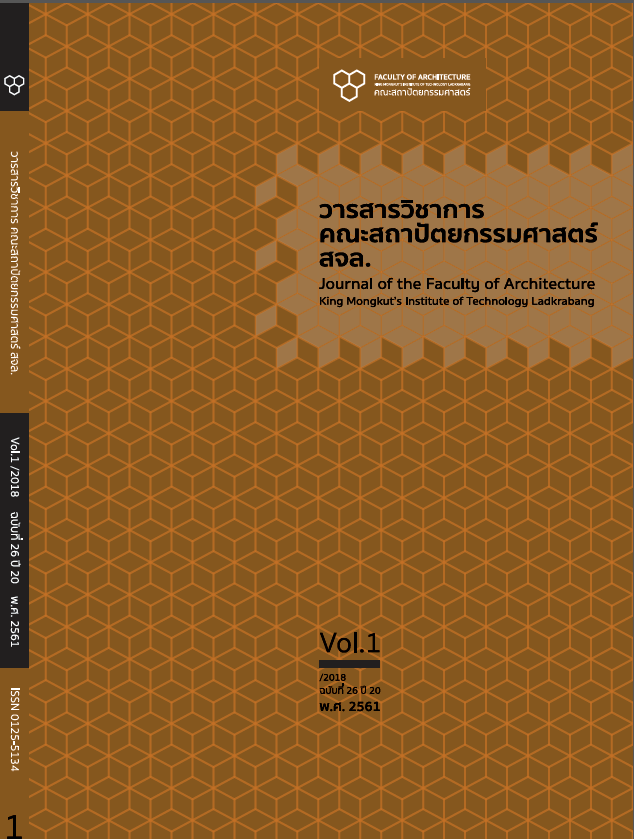อิทธิพลรูปแบบที่นั่งห้องเรียนต่อการเรียนรู้ของเด็กเรียนรู้ช้า, The Influence of Classroom Seating Arrangement on Student with Slow Learning
Main Article Content
Abstract
Abstract
This research examines the influence of seating arrangements on performance of student with learning difficulty (Slow-learner). The research focuses on how different types of seating pattern do effect students’
behaviors by investigating physical environments of Ban Hin Lat school. Non-participant observation was adopted with the target group interview, including 15 slow-learners from grades 4 to 5. Students’ behaviors were recorded during their learning activities, improving slow-learning symptom, both reading and writing in Thai language. According to 4 patterns of classroom seating arrangement, there are 2 patterns reducing learner’s concentration. The average amount of behaviors occurred in accordance with different seating patterns as follows; 1) patterns 1st and 3rd with 2 types of pathway; the front and side of the seats being visible and 2) patterns 2nd and 4th with the pathway on a side of the seats. The result shows that students’ seats should be arranged for minimizing visibility of the pathways and moments, and this can help them increase learning concentration.
Keywords: Learning Difficulty, Seating Pattern, Classroom
Article Details
This work is licensed under a Creative Commons Attribution-NonCommercial-ShareAlike 4.0 International License.
Copyright Transfer Statement
The copyright of this article is transferred to Journal of The Faculty of Architecture King Mongkut's Institute of Technology Ladkrabang with effect if and when the article is accepted for publication. The copyright transfer covers the exclusive right to reproduce and distribute the article, including reprints, translations, photographic reproductions, electronic form (offline, online) or any other reproductions of similar nature.
The author warrants that this contribution is original and that he/she has full power to make this grant. The author signs for and accepts responsibility for releasing this material on behalf of any and all co-authors.
References
นิพัทธา น้อยประวัติ. (2558). แบบจำลองสภาพแวดล้อมที่ส่งผลต่อพัฒนาการของเด็ก กรณีศึกษาการออกแบบสภาพแวดล้อม ที่เอื้อต่อกิจกรรมพัฒนาการของเด็กออทิสติก. (ปร.ด. สหวิทยาการ การวิจัยเพื่อการออกแบบ
(หลักสูตรนานาชาติ), สถาบันเทคโนโลยีพระจอมเกล้าเจ้าคุณทหารลาดกระบัง).
พระราชบัญญัติการศึกษาแห่งชาติ พุทธศักราช 2542. (2542, 14 สิงหาคม). ราชกิจจานุเบกษา. เล่ม 116 ตอนที่. 74 ก หน้า 1-28.
ผดุง อารยะวิญญู. 2546 วิธีสอนเด็กเรียนยาก กรุงเทพฯ: แว่นแก้ว.
อารียา สตารัตน์. (2456) การจัดสภาพแวดล้อมในสถานศึกษา ของโรงเรียนสังกัดกรุงเทพมหานคร สำนักงานเขตราชเทวี. (กศม. การบริหารการศึกษา, มหาวิทยาลัยศรีนครินทรวิโรฒ).
อุมาพร ตรังคสมบัติ. 2545 ช่วยลูกออทิสติก: คู่มือสำหรับพ่อแม่ผู้ไม่ยอมแพ้. กรุงเทพฯ: ศูนย์วิจัยและพัฒนาครอบครัว 2545.
Beaver, C. (2010). Autism-friendly environments, The autism file. 2010 (34), 82-85.
Conroy, M. A., Sutherland, K. S., Snyder, A. L., Marsh, S. (2008). Classwide interventions: Effective instruction makes a difference. TEACHING Exceptional Children. 40(6), 24-30.
Khare, R. and Mullick, A. (2008). Educational spaces for children with autism: design development process, In CIB W 084 International Meeting ‘Education And Training” Georgia Tech University. L. Biocca and
A. Morin (Eds.). Building Comfortable and Liveable Environment for All. (pp. 66–75). Atla. CNR ITC.
Conroy, M. A., Asmus, J. M., Boyd, B. A., Ladwig, C. N., and Sellers, J. A. (2007). Antecedent Classroom Factors and Disruptive Behaviors of Children with Autism Spectrum Disorders. Journal of Early Intervention.
30(1), 19-35.
Scott, I. (2009). Designing learning spaces for children on the autism spectrum, Good Autism Practice. 10(1), 36-51.
Vogel, C. L. (2008). Classroom design for living and learning with autism. University of Wisconsin-Madison Design Studies. Retrieved from http://www.designshare.com/index.php/articles/classroom_autism/

